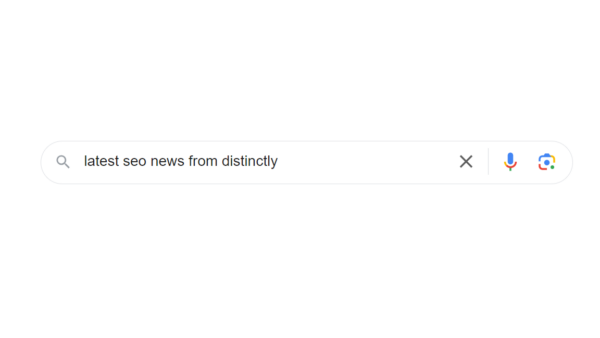Latest organic search news – May 25
We’ve compiled the essential updates from Google and the broader world of search from the last month – keeping you up to date with everything you need to know.
Covering
- The growing importance of About Us pages
- ChatGPT Shopping: what we know so far
- Buzzstream’s linkbuilding trends report
- Ecommerce SEO tests: quick wins and curveballs
- Are AI Overviews killing clicks?
- Visibility beats instinct when defining your competitors
- HARO is back!
- Don’t forget about Bing
- Stay ahead in SEO with Distinctly
The growing importance of About Us pages
This is a really interesting study by AI brand comprehension tool Waikay. They analysed over 17,000 URLs referenced by large language models (LLMs) in response to brand-related queries, uncovering just how vital About pages have become in shaping brand visibility within AI-generated content.
1. They are heavily used by LLMs as data sources
Notably, the most referenced page types by LLMs were:
- Home pages: 1,274 URLs
- About pages: 966 URLs
Despite typically being just one page per site, About pages represent 13% of all referenced URLs – a significant influence in algorithmic terms.
2. Why LLMs prefer About pages
LLMs strongly favour About pages because these pages:
- Are rich in brand identity: history, values, mission, and expertise.
- Offer structured, clear, and text-heavy content that’s ideal for semantic understanding.
- Contain stable and reliable information that doesn’t frequently change.
- Are authoritative, first-party sources, enhancing trustworthiness.
3. Risks of neglecting your About page
If your About page is weak or missing, you risk:
- Misinformation: LLMs may rely on third-party sources to fill informational gaps.
- Context loss: Vague content can lead to inaccurate representation of your niche, tone, or market position.
- Visibility loss: Poor-quality or outdated About pages can exclude your brand from generative AI answers, AI-generated summaries, and entity panels.
SEO strategy takeaway
Optimising your About page is no longer solely about user experience or branding. It now serves as a critical trust and authority signal for LLMs, directly influencing how your brand is represented in AI-powered search results and summaries.
ChatGPT Shopping: what we know so far
OpenAI has launched improved shopping results in ChatGPT, allowing users to search for products and see real-time listings with images, descriptions, pricing, and links to buy. The feature is currently available to ChatGPT Plus users within GPT-4 where browsing is enabled.
In their official update, OpenAI confirms that:
- Product listings are pulled from publicly available sources across the web
- Results are not paid placements – OpenAI is not compensated by sellers or platforms
- Listings are selected based on relevance, with a focus on live product data like price and availability
- The goal is to help users discover products that meet their needs
This marks a clear move toward AI-powered product discovery. For ecommerce brands, it signals a growing opportunity to appear where people are increasingly searching.
Where does Shopify fit in?
While OpenAI has not announced a formal partnership, early user tests and reporting from TestingCatalog, TechRadar, and Practical Ecommerce show that many of the first products surfaced in ChatGPT came from Shopify merchants.
These were not ads, but well-structured product pages with rich schema and accurate, up-to-date information. It is too early to call it an integration, but platforms that support clean product feeds and structured data, such as Shopify, appear well positioned to benefit.
What should ecommerce brands be doing now?
It is still early days, but there are practical steps brands can take to increase their chances of appearing:
- Ensure structured data (Schema.org) is implemented and accurate
- Make sure your site is accessible to AI crawlers (check robots.txt and dynamic content)
- Keep product feeds fresh with live pricing, availability, and strong metadata
- Strengthen third-party visibility through digital PR and trusted citations
What GPT prioritises when recommending products
In a related post, James Locke shared what GPT considers most important when deciding which products to show:
- Structured data (20%)
- Product page content (20%)
- Technical SEO (15%)
- Pricing and delivery transparency (10%)
- Images and media (10%)
- User experience and conversion (10%).
- Shopping feed compatibility, contextual content, trust signals, and ongoing maintenance
Monitor and test
It is early, but monitoring your visibility and referral traffic is the best place to start. If ChatGPT begins surfacing your products, understanding what is driving that visibility will help you adapt and scale.
Buzzstream’s linkbuilding trends report
BuzzStream’s 2025 Link Building Trends Report highlights how digital PR is being used by organisations and where there’s room to refine strategies. For organisations already using digital PR, authority building and brand awareness remain core objectives, as shown by current link priorities:
- 68% focus link building to blog content (e.g. campaigns)
- 44% prioritise the homepage
- Only 41% build links to product pages
- 16% target money pages with clear sales-focused CTAs
This isn’t surprising – we know that earning links to commercial pages is more challenging, as journalists naturally prefer to link to content that adds value for their readers or provides useful context for their stories. Digital PR doesn’t need to shift away from its core focus, but there are ways to make links work harder.
Tying in top or mid-funnel content (think data-led campaigns, or evergreen resources that work for passive linkbuilding) with product relevance or unique insights can lift overall domain authority while still supporting commercial performance. Campaigns that answer customer questions or use first-party data to naturally frame the value of a product or service can also naturally reinforce key pages without being overly promotional.
Looking ahead, 56% expect increased budgets in 2025, signalling stronger investment, but only 11% have a repeatable way to get cited in AI-generated content. That’s a huge opportunity for PRs to lead with formats that work across audiences and platforms: structured, valuable, and built with both journalists and algorithms in mind.
Ecommerce SEO tests: quick wins and curveballs
SearchPilot has released a fantastic pack of recent SEO experiments across retail and ecommerce sites. You can view all test results here, and I’d highly recommend signing up to their newsletter if you haven’t already.
As always, it’s not a playbook to blindly follow but a rich source of inspiration and testing ideas. Here are some of the most interesting outcomes:
Key wins
Small changes, big results:
- +50% traffic from adding Pros and Cons sections to product pages
– Structuring this content clearly helped improve rankings and attract long-tail queries. - +28% by removing category keywords from title tags and H1s
– Aligning metadata more closely with how users actually search. - +24% after deleting the word “Compare” from title tags
– Simplifying titles made them more attractive and better matched to search intent. - +22% from canonicalising to specific product variation pages
– Helped Google surface variant pages more accurately. - +15% uplift by putting brand names first in title tags
– Gained extra visibility and trust by leading with the brand. - +11% by adding the word “Best” to title tags
– Tapped into high-intent queries and boosted CTR. - +8.5% boost from capitalising keywords in title tags
– Made listings more eye-catching without harming perceived quality.
Surprises
Not everything performed as expected:
- –5.5% drop after removing breadcrumbs
– Caused a schema mismatch that hurt search visibility. - +4.1% uplift from removing video reviews
– Improved page load speed, especially on mobile. - No change after removing FAQ schema
– Likely because Google has de-emphasised FAQ snippets in SERPs.
The main takeaway? These results are incredibly useful, but they’re not universal. Just because something worked (or didn’t) for one site doesn’t guarantee the same for yours. The key is to test for yourself and learn from your own data as that’s where the real wins come from. So, get testing!
Are AI Overviews killing clicks
There’s been a lot of noise around Google’s AI Overviews (formerly SGE) and what they might mean for organic performance. Two recent pieces shed light from different angles and together, they tell a pretty clear story.
Last month, Ahrefs published a large-scale study analysing 300,000 keywords. The standout finding:
When an AI Overview appears, the top-ranking organic result sees a 34.5% drop in clickthrough rate on average.
That’s not a small shift – it’s a substantial dip, especially for informational queries, where Overviews are most prominent. Commercial and branded searches seem more stable, but the direction of travel is hard to ignore.
Kevin Indig, in his latest Growth Memo, zooms out from the raw numbers and looks at what this means strategically. His key point:
AI Overviews don’t just reduce clicks they reshape how users interact with the SERP.
He suggests they may not always cannibalise traffic, but instead redistribute it, sometimes benefiting content further down the page or in follow-up queries. That’s a big shift in how we think about rankings and visibility.
So what should SEOs be doing?
- Track where AI Overviews are appearing for your key terms, especially high-traffic informational queries.
- Monitor if and where your content is being cited within those Overviews. If not, look at how competitors are being featured.
- Prioritise clear, structured answers and high E-E-A-T signals to improve your chances of inclusion.
- Focus on follow-up intent as users might scroll or re-query after reading the Overview, so make sure your content is well-positioned to catch the next step.
- Expect the impact to vary by vertical, test and analyse before reacting across the board.
- Don’t panic, as in the majority of cases, informational clicks are not the ones that convert. Whilst traffic may be dropping, we are seeing revenue much less impacted.
The bottom line?
AI Overviews are already changing how people search. At Distinctly this month, we’ve created a dashboard that pulls through landing pages and snippets of text being clicked on in AIOs – feel free to reach out if this is something of interest to you, as Google hasn’t released its own data on this (and may never).
Understanding what content is being featured and what people click on is the first step to working out how to maximise those clicks – and how to appear in the first place.
Visibility beats instinct when defining your competitors
A timely reminder from Steve Paine at SISTRIX this month: when analysing your competitors, don’t rely on instinct or ‘top of mind’ brand lists – use search visibility data.
In a recent SectorWatch analysis of online grocery shopping, SISTRIX found that some of the most visible sites weren’t the obvious household names. For example, niche players like onlinefruitandveg.com, donaldrussell.com, and myexoticfruit.com all ranked higher in visibility than big brands like Lidl or Aldi who didn’t appear at all, with Sainsbury’s also down in ninth spot.
The top five for digital visibility in this space?
- tesco.com
- amazon.co.uk
- asda.com
- onlinefruitandveg.com
- morrisons.com
Tesco has recently overtaken Amazon in the rankings, thanks to visible improvements across its product and category pages. It’s a good example of how smart optimisation can shift the competitive landscape.
But it’s not just about transactional visibility. The same SISTRIX post highlights how content marketing projects (recipe hubs, blogs and editorial sections) are playing a key role in the grocery space.
Here, realfood.tesco.com, waitrose.com/home/recipes, and sainsburysmagazine.co.uk all show strong visibility, with more niche efforts from Ocado and Morrisons gaining traction too.
This kind of content-led visibility isn’t just about traffic; it builds brand relevance across a wider set of queries and supports long-term trust and engagement. It’s also where competitors you’ve never heard of can quietly build a share of voice.
As Steve puts it, data-led competitor analysis is essential for:
- Blueprints for success
- Gap analysis
- Keyword research
- Brand benchmarking
- Due diligence
- Spotting new competitors
Takeaway: Your real competitors aren’t who you think they are, they’re who’s showing up when customers search. Whether it’s product visibility or recipe content, search data reveals the actual digital shelf space.
If you’re exploring this for your brand, SISTRIX’s SectorWatch reports and keyword-based tools are a fast, practical place to start.
HARO is back!
Help a Reporter Out (HARO) is a well-known media request platform which returned as an email newsletter in April this year.
Being primarily US-based, it’s a great addition to supplement current media request platforms that primarily share UK opportunities. HARO works to connect journalists with credible sources, making it a beneficial tool for reactive PR, especially in fast-paced news cycles. While not a core tactic for every campaign, it’s a solid tool to have in your back pocket.
Don’t forget about Bing
Something I posted on LinkedIn recently that’s worth sharing here too: Bing shouldn’t be ignored in your SEO strategy, especially if you’re getting even a small share of traffic from it.
For one client, Bing accounted for 10% of organic traffic and 3% of total conversions; far ahead of anything coming from LLM-powered sources like ChatGPT. And yet, dozens of high-priority queries that ranked well on Google had zero visibility in Bing.
It’s not just about search either. Bing powers ChatGPT’s browsing, Microsoft Copilot, and other AI search layers, making visibility there more important than it first appears.
A few quick steps if you haven’t done this yet:
- Check GA4 and Bing Webmaster Tools for traffic and conversion data
- Cross-reference with Google Search Console
- Look for missed opportunities where you rank well in Google but are absent in Bing
- Run URL inspection in Bing – even small flags could point to missed optimisation wins
Bing will never catch up to Google but if it’s already driving meaningful traffic and conversions, it deserves more attention than it often gets.
Stay ahead in SEO with Distinctly
Enjoyed this roundup? Stay updated with the latest Organic trends, tips, and exclusive insights by subscribing to our newsletter.



